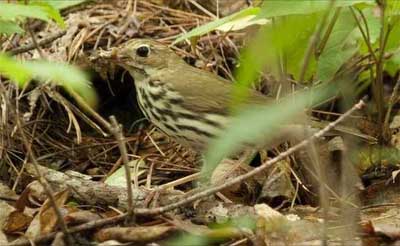 Ground-nesting birds eavesdrop on chipmunks in order to protect their nests, according to scientists.
Ground-nesting birds eavesdrop on chipmunks in order to protect their nests, according to scientists.
Ovenbirds and veeries live alongside egg-eating chipmunks in the Hudson Valley, New York, US.
Researchers have found that when simulated chipmunk calls are played, the birds nest up to 20 metres further away.
The study is the first to show that birds heed the chatter of non-avian species.
Previous studies have highlighted how various species of birds eavesdrop on each other to identify troublemakers, find good nest sites and avoid potential threats.
The new evidence that some species of bird also listen in on mammals is published in the British Ecological Society’s Journal of Animal Ecology.
Eastern chipmunks (Tamias striatus) belong to the same family as squirrels and are found throughout eastern North America.
Scientists have recorded chipmunks communicating in high-pitched “chips” and lower-pitched “chucks” as well as quieter “trills” of twittery notes.
Dr Kenneth Schmidt and PhD student Quinn Emmering from Texas Tech University investigated whether the distinctive sounds were heeded by other forest residents.
“Chipmunks are vociferous, calling often during the day and sometimes joining in large choruses,” explained Mr Emmering.
“We thought this might be a conspicuous cue that nesting birds could exploit.”
By recording the chipmunk calls and playing them in the forest, Mr Emmering and Dr Kenneth Schmidt were able to measure the response by neighbouring birds.
They also set up playbacks of tree frogs and areas without simulated calls as control sites.
Canopy-dwelling birds were uninterrupted by the chipmunk calls but those species nesting on the ground paid considerably more attention.
“We found that by eavesdropping on chipmunk calls, the birds can identify hotspots of chipmunk activity on their breeding grounds, avoid these areas and nest instead in relatively chipmunk-free spots,” Mr Emmering said.
Ovenbirds nested up to 20 metres further away from chipmunk call sites than the “silent” sites.
Veeries also nested further from the calls but only by an average of 9.4 metres.
“I was surprised by veeries weakly responding, as their nests are built no higher than a metre making them easily susceptible to chipmunks who regularly scramble up shrubs and trees,” said Mr Emmering.
He suggests this may be because the birds have habitat preferences and alternative predators that may limit their nest-site choice.
Veeries are forest thrushes and ovenbirds are larger, squat-shaped warblers named for their dome-shaped nests said to resemble a Dutch oven.
-With bbc.co.uk input



